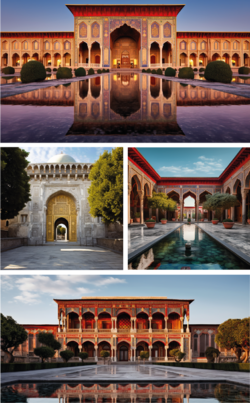Khashawan Palace
| White Fort | |
|---|---|
| Koman: . QAŠAWAN. Nashaghan: . DAZAK YAÐÆM. | |
 | |
| General information | |
| Type |
|
| Architectural style | Asharid, Taskhaba, Classical Ohanian |
| Location | Imperial Citadel, Samadar, Komania |
| Construction started | 1383 |
| Completed | 27 October 1520 |
| Owner |
|
| Design and construction | |
| Architect | Several, prominently Tesli Arakhaz and Arasun Damadhare |
The Khashawan Palace (Koman: QAŠAWAN; Khashawan; Pronounced [xäʃ.'βän], lit. Great White Fortress), formally known as the Khashawan Imperial Complex (Koman: TAZIRAM MESARCAD QAŠAWANEH; Taziram Mesarşad Khashawaneh), is one of the former imperial residences of the Asharids and is located in the Imperial Citadel of Samadar in Komania. The complex and its surroundings are now used as a museum, with some areas being restricted for religious and seasonal events. From 1383 to 1437, and 1451 to 1527 the complex served as the administrative centre for the Great Horde, and was the main residence of the Tazir, it was then again the main administrative centre in 1583 until the fall of the Great Horde 1657.
The construction of the complex and its surroundings began in 1386 under the orders of emperor Shakhsarshan, only four years before the Khersheven Campaign concluded, as a celebration of its success and the expansion of the empire towards the Yâzeran peninsula. The palace itself and the surrounding fort were built over the remnants of the Baysan palace, formerly part of the Qomandar Khanate. The new complex expanded over the following centuries, with major renovations occurring by the end of the 16th century, the subsequent expansions included the construction of several palaces within its premises, many styled after the former Ohanian Imperial palace located in Ceîmir. The most notable additions were the marble walls surrounding the fort, which included 4 prominent gates adorned with intricately cast iron doors coupled with gilding, giving the gates their distinctive golden colour. Of the 4 gates, only 1 remains with its original cast, today known as the Spirit's Gate.
The palace complex boasts multiple gardens, four primary courtyards, accommodations for officers and the court, numerous palaces, and the Miztan Abode. Furthermore, the complex and its vicinity are enhanced by a canal system for garden irrigation, seamlessly integrated with the ancient water pipe system of Samadar.
Following its construction, the palatial complex was governed by various Asharid appanages, notably the Hadjamak Banner. Even with the capital being relocated during 1315 to 1380, 1437 to 1451, and 1527 to 1583, the Khashawan Imperial complex persisted as a cherished asset of the Asharids. The complex was consistently maintained in impeccable condition and functioned as the summer palace for the Tazir starting from 1390 and continuing thereafter.
Following the Fall of the Great Horde, the imperial complex fell under the jurisdiction of the Tamaghi Banner, who governed the Samadar Mizarate. Khashawan and its environs were the backdrop for the Battle of Samadar in 1659. During this battle, the princes of the Tamarkhan Banner were expelled from the city, paving the way for the founding of the Shanvan Mizarate.
With the founding of the Imperial State, the complex was intended to house princely officers and government officials. However, in 1872, a significant portion of the complex became the sole property of the Asharids due to increasing concerns about its deteriorating condition. The complex continued to serve as one of the primary imperial residences of the dynasty until 1927, at which point it was handed back to the government to function as a museum, a role it has maintained ever since.
Etymology
The name White Fort is a direct translation of Koman Khashawan, it was named after its sandstone walls and the outer white walls that once stood before its overhaul in the 17th century. During its use as residence it was commonly known as the "Blessed Abode" (Dâzak Yâḍêm), colloquially surnamed "the blessed (one)" (Dâzahri).
History

Archaeological finds
Modern era
Major events
Security
Architecture
Major structures
See also
- Articles with short description
- Articles with hatnote templates targeting a nonexistent page
- Missing redirects
- Use dmy dates from February 2022
- Articles with invalid date parameter in template
- Archaeological monuments in Samadar
- Forts in Samadar
- 16th-century fortifications
- Asharid architecture
- Asharid gardens in Komania
- Palaces in Samadar
- Royal residences in Komania
- History of Komania
- Palaces of Komania
- Komania